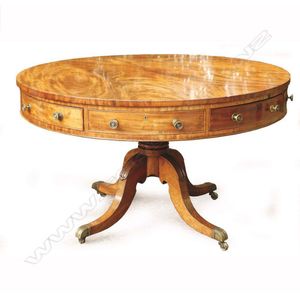William IV Mahogany Drum Table with Brass Accents
You must be a subscriber, and be logged in to view price and dealer details.
Subscribe Now to view actual auction price for this item
When you subscribe, you have the option of setting the currency in which to display prices to $Au, $US, $NZ or Stg.
- Mahogany - Mahogany is a dense, close grained red-coloured timber from the West Indies and Central America. It was first imported into Europe in the the early 18th century and its use continued through the 19th century. It was popular for furniture making because of its strength, the wide boards available, the distinctive grain on some boards, termed flame mahogany and the rich warm colour of the timber when it was polished.. The "flame" was produced where a limb grew out from the trunk of the tree, and this timber was usually sliced into veneers for feature panels on doors, backs and cornices.
Some terms used to describe mahogany relate to the country from which it originally came, such as "Cuban" mahogany, "Honduras" mahogany etc. However unless the wood has been tested the names assigned are more a selling feature, rather than a true indication of the timber's origin. - William Iv - William IV was King of the United Kingdom and King of Hanover from 26 June 1830 until his death in 1837, and in English furniture design it represented the brief period between the end of the Regency period, and the beginning of the Victorian period.
- Turning - Any part of a piece of furniture that has been turned and shaped with chisels on a lathe. Turned sections include legs, columns, feet, finials, pedestals, stretchers, spindles etc. There have been many varieties and fashions over the centuries: baluster, melon, barley-sugar, bobbin, cotton-reel, rope-twist, and so on. Split turning implies a turned section that has been cut in half lengthwise and applied to a cabinet front as a false decorative support.
- Column - An architectural feature sometimes used for decorative effect and sometimes as part of the supporting construction. Columns should generally taper slightly towards the top. They may be plain or decorated with carving, fluting or reeding. Columns may be fully rounded or, more commonly, half-rounded and attached with glue, screws or pins to the outer stiles of doors, or the facing uprights on cabinets and bureaux.
- Faux - A French word meaning "false", but when used in decorative arts, the intention is not to deceive, but to simulate the decorative effects of the more expensive material it is imitating. The term " faux bois" meaning "false wood" refers to a furniture item that has been decorated with a marked grain (woodgrain finish) to imitate a more expensive timber.
This item has been included into following indexes:
Visually similar items

A 19th century, mahogany drum table on four scroll legs, circa 1840, bleaching to wood work and writing surface in places, 128.5 cm diameter x 79 cm high

Regency crossbanded rosewood tilt top centre table, 19th century, the circular top with brass inlay, on downswept legs with brass castors. Height 70 cm diameter 126 cm

A Regency mahogany revolving top, drum table, first quarter of the 19th century, with a later tooled green leather top above four drawers and four dummy frieze drawers, each with brass Prince of Wales feather moulded ring handles, the turned pillar on four

A burr walnut & oak oval occasional table, in very good condition
